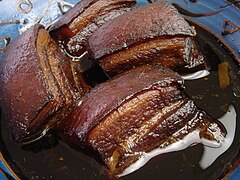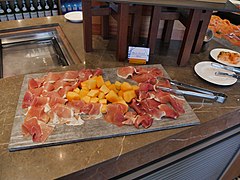Pork/ja: Difference between revisions
Created page with "== 栄養 == {{nutritionalvalue/ja | name=豚肉、新鮮、ロース、丸ごと、<br />分離可能な赤身と脂肪、<br />調理、炙り | kJ=1013 | protein=13.32 g | fat=27.92 g | satfat=5.230 g | monofat = 6.190 g | polyfat = 1.200 g | carbs=0.00 g | calcium_mg= 19 | copper_mg = 0.073 | iron_mg=0.87 | magnesium_mg=28 | phosphorus_mg=246 | potassium_mg=423 | sodium_mg=62 | zinc_mg=2.39 | vitB6_mg=0.464 | vitB12_ug=0.70 | vitC_mg=0.6 | choline_mg=93.9..." |
Created page with "{{bq|あなたがたに禁じられているのは、死肉、血、豚の肉、アッラー以外の名で屠られたもの、絞殺されたもの、打ち殺されたもの、墜落死したもの、角で突かれて死んだもの、猛獣に食われた残り(ただしあなたがたが屠った場合を除く)、および祭壇に捧げられたもの。また、くじによる運命決定も禁じられている。これはすべて悪である..." |
||
| (31 intermediate revisions by the same user not shown) | |||
| Line 80: | Line 80: | ||
[[:en:Philippines|フィリピン]]では、300年にわたるスペインの植民地支配と影響により、仔豚を丸ごと焼いた[[lechon/ja|レチョン]]が国民的珍味となっている。 | [[:en:Philippines|フィリピン]]では、300年にわたるスペインの植民地支配と影響により、仔豚を丸ごと焼いた[[lechon/ja|レチョン]]が国民的珍味となっている。 | ||
== 国別生産量 == | |||
[[File:HK Sai Ying Pun 豬肉 Pork hanging half n half August 2017 IX1 02.jpg|thumb|upright|香港・西營盤にて吊るされた豚の[[Dressed carcass/ja|枝肉]]と[[offal/ja|内臓]]]] | |||
[[File:HK Sai Ying Pun 豬肉 Pork hanging half n half August 2017 IX1 02.jpg|thumb|upright| | 2020年において、世界最大の豚肉生産国は中国であり、これに[[:en:European Union|欧州連合]]および[[:en:United States|アメリカ合衆国]]が続いた。 | ||
中国、EU、アメリカ合衆国の3地域で、世界の豚肉生産量のおよそ76%を占めている([[:en:Foreign Agricultural Service|FAS]]/[[:en:United States Department of Agriculture|USDA]]調べ) | |||
{| class="wikitable" | {| class="wikitable" | ||
|+ | |+豚肉を最も多く生産する上位10か国 | ||
! | !順位 | ||
! | !国 | ||
! | !2020年(メートルトン) | ||
! | !世界シェア | ||
|- | |- | ||
|1 | |1 | ||
|[[China]] | |[[:en:China|中国]] | ||
|36,340,000 | |36,340,000 | ||
|37.58% | |37.58% | ||
|- | |- | ||
|2 | |2 | ||
|[[European Union]] | |[[:en:European Union|欧州連合]] | ||
|24,150,000 | |24,150,000 | ||
|24.97% | |24.97% | ||
|- | |- | ||
|3 | |3 | ||
|[[United States]] | |[[:en:United States|アメリカ合衆国]] | ||
|12,843,000 | |12,843,000 | ||
|13.28% | |13.28% | ||
|- | |- | ||
|4 | |4 | ||
|[[Brazil]] | |[[:en:Brazil|ブラジル]] | ||
|4,125,000 | |4,125,000 | ||
|4.27% | |4.27% | ||
|- | |- | ||
|5 | |5 | ||
|[[Russia]] | |[[:en:Russia|ロシア]] | ||
|3,611,000 | |3,611,000 | ||
|3.73% | |3.73% | ||
|- | |- | ||
|6 | |6 | ||
|[[Philippines]] | |[[:en:Philippines|フィリピン]] | ||
|2,467,000 | |2,467,000 | ||
|2.55% | |2.55% | ||
|- | |- | ||
|7 | |7 | ||
|[[Canada]] | |[[:en:Canada|カナダ]] | ||
|2,130,000 | |2,130,000 | ||
|2.20% | |2.20% | ||
|- | |- | ||
|8 | |8 | ||
|[[Mexico]] | |[[:en:Mexico|メキシコ]] | ||
|1,451,000 | |1,451,000 | ||
|1.50% | |1.50% | ||
|- | |- | ||
|9 | |9 | ||
|[[South Korea]] | |[[:en:South Korea|韓国]] | ||
|1,403,000 | |1,403,000 | ||
|1.45% | |1.45% | ||
|- | |- | ||
|10 | |10 | ||
|[[Japan]] | |[[:en:Japan|日本]] | ||
|1,298,000 | |1,298,000 | ||
|1.34% | |1.34% | ||
|} | |} | ||
== 豚肉製品 == | |||
[[File:Smoked country style pork ribs.jpg|thumb|スモークされた[[pork ribs/ja|ポークリブ]]]] | |||
[[File:Smoked country style pork ribs.jpg|thumb| | 豚肉は生肉のまま調理される場合もあれば、時間をかけて加工される場合もある。加工肉製品には[[ham/ja|ハム]]や[[bacon/ja|ベーコン]]が含まれる。豚の枝肉はさまざまな[[meat cuts/ja|部位]]に分けられ、生肉として利用されるが、どの部位が好まれるかは国や地域によって異なる。 | ||
=== 生肉 === | |||
== | 豚の大部分は生肉として利用することができる。[[suckling pig/ja|乳飲み子豚]]の場合は、生後2〜6週間の若い豚の全身を丸ごと焼く。デンマークのローストポーク、すなわち''[[flæskesteg/ja|フレスケスタイ]]''は、[[Pork rind/ja|豚の皮]]をカリカリに仕上げたものであり、伝統的なクリスマスディナーとして国民に親しまれている。 | ||
=== 加工豚肉 === | |||
[[File:Bologna amazing hams sausages mortadella.jpg|thumb|right|upright=1.3|イタリア・[[:en:Bologna|ボローニャ]]の精肉店に並ぶ[[ham/ja|ハム]]、[[pig's trotter/ja|豚足]]、[[salami/ja|サラミ]]、[[mortadella/ja|モルタデッラ]]]] | |||
[[File:Bologna amazing hams sausages mortadella.jpg|thumb|right|upright=1.3| | |||
豚肉は[[sausage/ja|ソーセージ]]の材料として特に一般的である。[[chorizo/ja|チョリソー]]、[[fuet/ja|フエ]]、[[Cumberland sausage/ja|カンバーランド・ソーセージ]]、[[salami/ja|サラミ]]など、多くの伝統的なヨーロッパのソーセージが豚肉を使用しており、ジューシーな仕上がりとなる。アメリカの[[hot dogs/ja|ホットドッグ]]の多くのブランドや、朝食用ソーセージの大半も豚肉から作られている。フランスにおける豚肉を用いたソーセージやその他の加工品の製造は[[charcuterie/ja|シャルキュトリ]]と呼ばれる。 | |||
[[ham/ja|ハム]]や[[bacon/ja|ベーコン]]は、生の豚肉を塩漬け([[pickling/ja|酢漬け]])や[[smoking (food)/ja|燻製]]によって加工して作られる。肩や脚は通常この方法で[[curing (food preservation)/ja|加工]]され、ピクニックショルダーや[[ham/ja|ハム]]として提供される。一方、ベーコンは腹部や背中から切り出され、背中の肉から取られるものは「ラウンドベーコン」、腹部からのものは「ストリーキーベーコン」と呼ばれる。 | |||
[[ | |||
ハムやベーコンは西洋において人気のある食品であり、産業化の進展とともにその消費量は増加している。非西洋料理でも保存肉製品は使用されており、例えば中国やアジア料理では塩漬けされた保存豚肉や紅焼き豚肉が用いられている。 | |||
==== ベーコン ==== | |||
==== | {{Main/ja|Bacon/ja}} | ||
{{Main|Bacon}} | [[File:Bacon texture.jpg|thumb|right|ベーコンの質感]] | ||
[[File:Bacon texture.jpg|thumb|right| | ベーコンは、側部、腹部、背中などから切り出された[[Primal cut/ja|部位]]の[[meat/ja|肉]]で、塩漬けまたは燻製されたものを指す。大陸ヨーロッパでは、立方体([[:en:lardon|ラルドン]])にして料理の材料として使用され、[[fat/ja|脂]]源および風味付けとして重宝されている。[[:en:Italy|イタリア]]では、料理に使われるほか、''[[pancetta/ja|パンチェッタ]]''として生のまま薄くスライスされ、''[[antipasto/ja|アンティパスト]]''の一部として供される。ベーコンはまた、特に野鳥などのローストにおいて[[Bacon/ja#Bacon fat|バーディング]]にも使用される。ベーコンはさまざまな木材を燃料にして最大10時間燻製される。調理法としては、揚げる、焼く、グリルするなどが一般的である。 | ||
スライスされていないベーコンの一枚は「フリッチ」または「スラブベーコン」と呼ばれ、個別のスライスは「ラッシャー」(オーストラリア、アイルランド、ニュージーランド、イギリス)または単に「スライス」あるいは「ストリップ」(北米)と呼ばれる。ベーコンのスライスは「[[collops/ja|コロップス]]」としても知られている。伝統的には皮が付いたままであり「ベーコンの皮」と呼ばれるが、皮なしベーコンも一般的である。[[:en:Republic of Ireland|アイルランド]]および[[:en:United Kingdom|イギリス]]では、ベーコンにはさまざまなカットと風味が存在し、主に「ストリーキーベーコン」あるいは「ストリーキーラッシャー」として知られている。豚の背中の肉から作られるベーコンは「[[back bacon/ja|バックベーコン]]」と呼ばれ、[[full breakfast/ja|イギリス]]や[[:en:Ireland|アイルランド]]で一般的に食べられている伝統的な[[full breakfast/ja|朝食]]の一部である。アメリカ合衆国では、バックベーコンは「カナディアンスタイル・ベーコン」あるいは「カナディアン・ベーコン」とも呼ばれる。 | |||
缶詰食品である[[Spam (food)/ja|スパム]]は、豚の肩肉およびハムを刻んで作られている。 | |||
== 産業用原料 == | |||
= | 豚が本来人間向けに用意されたが未使用となった食品を食べることができる点、そしてこうした食品が多くの工業化された国で大量に入手可能であることから、豚肉および豚由来製品は安定して供給され、低価格な商品となっている。このため、豚由来製品は多くの工業的製品における原材料として非常に人気が高い。 | ||
== {{anchor|cuts}} カット == | |||
== {{anchor|cuts}} | {{Main article/ja|Cut of pork/ja}} | ||
{{Main article|Cut of pork}} | |||
[[File:Kowloon Market (46068705804).jpg|thumb|新鮮な豚肉の切り身]] | |||
[[File:Kowloon Market (46068705804).jpg|thumb| | |||
== 栄養 == | == 栄養 == | ||
| Line 251: | Line 223: | ||
| source_usda=1}} | | source_usda=1}} | ||
その[[Myoglobin/ja|ミオグロビン]]含有量は牛肉より少ないが、鶏肉よりはるかに多いため、[[:en:United States Department of Agriculture|アメリカ合衆国農務省]](USDA)は豚肉を[[Red meat/ja|赤肉]]として扱っている。1987年、アメリカ合衆国の[[:en:National Pork Board|全米豚肉協会]]は、「[[:en:Pork._The_Other_White_Meat|もう一つの白肉]]」として豚肉を位置づける広告キャンペーンを開始した。これは、鶏肉や[[Turkey (bird)/ja|七面鳥]](白肉)が赤肉よりも健康的であるという世間の認識があったためである。このキャンペーンは大成功を収め、消費者の87%が豚肉をこのスローガンと結びつけるようになった。同協会は2011年3月4日にこのスローガンを廃止した。 | |||
豚肉は[[Thiamine/ja|チアミン]](ビタミンB<sub>1</sub>)を非常に多く含む。脂肪を切り落とした豚肉は、ほとんどの家畜の肉よりも赤身であるが、[[Cholesterol/ja|コレステロール]]と[[Saturated fat/ja|飽和脂肪]]を多く含む。 | |||
== 宗教的信仰 == | |||
== | {{Main article/ja|:en:Religious restrictions on the consumption of pork}} | ||
{{Main article|Religious restrictions on the consumption of pork}} | 豚肉の摂取は、[[:en:Jewish dietary laws|ユダヤ教の食事規定]]および[[:en:Islamic dietary laws|イスラム教の食事規定]]により禁じられており、また主流の[[:en:Seventh-day Adventist Church|セブンスデー・アドベンチスト教会]]、[[:en:Rastafarian|ラスタファリ運動]]、および[[:en:Ethiopian Orthodox Tewahedo Church|エチオピア正教テワヘド派教会]]の信者も豚肉を避ける。スコットランドでは、[[:en:Scottish pork taboo|1800年頃まで豚肉がタブーであった]]という説も存在する。 | ||
=== ユダヤ教 === | |||
=== | 豚肉は[[:en:kosher foods|非コーシャ食品]]の代表的な例である。この禁止は[[:en:Leviticus|レビ記]]第11章および[[:en:Deuteronomy|申命記]]第14章に基づいている。 | ||
<blockquote>これは、地にいるすべての動物の中で、あなたがたが食べてもよいものの一覧である。ひづめが分かれており、しかも反芻する動物は、食べてもよい。しかし、反芻するかひづめが分かれているかの一方しか持たないものは、食べてはならない。たとえば、らくだは反芻するがひづめが分かれていない...豚は、ひづめが分かれており完全に割れてはいるが、反芻しないので、あなたがたには汚れたものであり、その肉を食べてはならない。 | |||
<blockquote> | :—レビ記 11:2–4, 7–8</blockquote> | ||
: | |||
<blockquote>豚は、ひづめが分かれているが、反芻しないため、その肉を食べてはならない。 | |||
<blockquote> | :—申命記 14:8</blockquote> | ||
: | |||
これらのトーラーの節が示す通り、豚肉は非コーシャである。なぜなら、ユダヤ人は、ひづめが割れていることと反芻することの両方の特徴を備えていない動物を食べてはならないからである。[[ruminant/ja|反芻動物]]ではない豚は、[[cattle/ja|牛]]や[[sheep/ja|羊]]のように反芻しない。実践的なユダヤ教徒は、豚を「汚れたもの」とする聖書の説明を十分とみなす。マイモニデスもまた、豚をその習性と食性の両面で不浄な生物と見なし、この見解を共有した。 | |||
[[Ancient Israelite cuisine/ja|古代イスラエル料理]]における豚食の禁止について、ダグラスは、豚が非イスラエル人によって飼育され、[[:en:carrion|死肉]]を食べ、[[:en:ungulates|偶蹄類]]の分類に合致しなかったためであると述べる。一方でハリスはこれに異を唱え、エジプト人やシュメール人も豚を制限していたこと、ヤギも死体を食べるにもかかわらず古代イスラエルでは不浄とされなかったことを指摘する。ハリスはむしろ、環境的および経済的要因による説明を提示している。 | |||
[[:en:Israel|イスラエル]]では、豚の飼育は法律によって特定の地域や機関に限定されている。一部の豚関連法はあからさまに回避されている。豚の生産は、1960年の年間推定屠殺数5万頭から2010年には18万頭に増加した。2009年における一人当たりの豚肉消費量は2.7kgであった。宗教的地域では豚肉の販売が禁止されているが、それ以外の場所では非コーシャの肉屋や[[:en:Tiv Ta'am|ティブ・タアム]]など、[[:en:Russian Jews in Israel|ロシア系移民]]向けの非コーシャスーパーマーケットチェーンで豚肉製品が販売されている。現代ヘブライ語における豚肉の婉曲表現は「白い肉」である。 | |||
=== イスラム教 === | |||
== | [[File:Dubai Pork Shop.jpg|thumb|[[:en:Dubai|ドバイ]]([[:en:United Arab Emirates|アラブ首長国連邦]])の豚肉店。「非ムスリム向け」との表示あり]] | ||
[[File:Dubai Pork Shop.jpg|thumb| | 豚肉は[[:en:Islamic dietary laws|イスラム教の食事規定]]により禁じられている。[[:en:Islamic world|イスラム世界]]全体において、多くの国々が豚肉製品の輸入または消費を厳しく制限している。たとえば、[[:en:Iran|イラン]]、[[:en:Mauritania|モーリタニア]]、[[:en:Oman|オマーン]]、[[:en:Qatar|カタール]]、[[:en:Saudi Arabia|サウジアラビア]]、[[:en:Algeria|アルジェリア]]、[[:en:Turkmenistan|トルクメニスタン]]、[[:en:Uzbekistan|ウズベキスタン]]、[[:en:Tajikistan|タジキスタン]]、[[:en:Yemen|イエメン]]、[[:en:Somalia|ソマリア]]、[[:en:Sudan|スーダン]]、[[:en:Afghanistan|アフガニスタン]]、[[:en:Djibouti|ジブチ]]、[[:en:Kuwait|クウェート]]、[[:en:Mali|マリ]]、[[:en:Niger|ニジェール]]、[[:en:Senegal|セネガル]]、[[:en:Gambia|ガンビア]]、[[:en:Libya|リビア]]、[[:en:Pakistan|パキスタン]](一部コミュニティを除く)、および[[:en:Maldives|モルディブ]]などがある。しかし、[[:en:Indonesia|インドネシア]]([[:en:Aceh|アチェ州]]を除く)、[[:en:Malaysia|マレーシア]]、[[:en:Brunei|ブルネイ]]、[[:en:Lebanon|レバノン]]、[[:en:Iraq|イラク]]、[[:en:Tunisia|チュニジア]]、[[:en:Egypt|エジプト]]、[[:en:Morocco|モロッコ]]、[[:en:Bahrain|バーレーン]]、[[:en:Bangladesh|バングラデシュ]]、[[:en:Kyrgyzstan|キルギス]]、[[:en:Kazakhstan|カザフスタン]]、[[:en:Jordan|ヨルダン]]、[[:en:Albania|アルバニア]]、[[:en:Azerbaijan|アゼルバイジャン]]、[[:en:Turkey|トルコ]]、[[:en:Bosnia and Herzegovina|ボスニア・ヘルツェゴビナ]]、[[:en:Kosovo|コソボ]]、[[:en:Syria|シリア]]、[[:en:Sierra Leone|シエラレオネ]]、[[:en:Guinea|ギニア]]、[[:en:Chad|チャド]]および[[:en:United Arab Emirates|アラブ首長国連邦]]([[:en:Emirate of Sharjah|シャールジャ首長国]]を除く)など、非ムスリム人口が多いイスラム教多数国では、ホテル、レストラン、スーパーマーケットにおいて豚肉が提供されている。 | ||
[[:en:Qur'an|クルアーン]]における豚肉禁止の根拠は以下に示されている。 | |||
{{Blockquote|アッラーは、あなたがたに[[:en:carrion|死肉]]、血、[[:en:swine|豚]]、およびアッラー以外の名で屠られたものを禁じた。ただし、必要に迫られ、欲望にかられず、また度を超えない範囲であれば、罪はない。まことにアッラーは寛容にして慈悲深い。|}} | |||
{{Blockquote| | |||
{{bq|あなたがたに禁じられているのは、死肉、血、豚の肉、アッラー以外の名で屠られたもの、絞殺されたもの、打ち殺されたもの、墜落死したもの、角で突かれて死んだもの、猛獣に食われた残り(ただしあなたがたが屠った場合を除く)、および[[:en:altar|祭壇]]に捧げられたもの。また、くじによる運命決定も禁じられている。これはすべて悪である。今日、不信者はあなたがたの宗教に絶望した。だから彼らを恐れるな、わたしを恐れよ。今日、わたしはあなたがたの宗教を完成し、わたしの恩恵をあなたがたに全うし、イスラムを宗教として選んだ。ただし、極度の飢えに迫られ、罪を犯す意図がなければ、まことにアッラーは寛容にして慈悲深い。|}} | |||
{{bq| | |||
{{bq|言え、「わたしに啓示されたものの中で、食してはならないと禁じられたものを見出さない。ただし、それが死肉、流れる血、豚肉(これは汚れたものである)、またはアッラー以外の名で捧げられた罪深い供物である場合は別である。しかし、必要に迫られ、欲望に駆られず、また度を超えないのであれば、まことにあなたの主は寛容にして慈悲深い。」|}} | |||
{{bq| | |||
{{bq|アッラーは、あなたがたに死肉、血、豚、アッラー以外の名で屠られたものを禁じた。ただし、必要に迫られ、欲望に駆られず、また度を超えない場合には、まことにアッラーは寛容にして慈悲深い。|}} | |||
{{bq| | |||
=== キリスト教 === | |||
[[File:Christmas table (Serbian cuisine).jpg|thumb|[[Cuisine of Serbia/ja|セルビアのクリスマス料理]]としての焼き豚]] | |||
[[File:Christmas table (Serbian cuisine).jpg|thumb| | 大多数のキリスト教徒は豚肉を摂取するが、一部の宗派では、[[:en:Leviticus|レビ記]]第11章、[[:en:Deuteronomy|申命記]]第14章、および[[:en:Isaiah|イザヤ書]]第65章・66章を根拠として豚肉を禁じている。豚肉を禁じている宗派には以下が含まれる。 | ||
* [[:en:Hebrew Roots|ヘブライ・ルーツ運動]] | |||
* [[Hebrew Roots]] | * [[:en:Messianic Judaism|メシアニック・ジュダイズム]] | ||
* [[Messianic Judaism]] | * [[:en:Seventh-day Adventist Church|セブンスデー・アドベンチスト教会]] | ||
* [[Seventh-day Adventist Church| | * [[:en:United Church of God|神の教会連合]] | ||
* [[United Church of God]] | * [[:en:Sacred Name Movement|聖名運動]] | ||
* [[Sacred Name Movement]] | |||
リバプール市議会のキリスト教正教徒間の初の宗教間昼食会において豚肉が提供されなかった際、[[:en:Macedonian Orthodox Church|マケドニア正教会]]の一部メンバーが異議を唱えた。彼らは、[[:en:Ottoman era|オスマン時代]]における共同体にとって豚肉料理が歴史的に重要であると主張し、[[:en:Eastern Orthodox|正教徒]]に対する差別であると苦情を呈した。これに対し、市議会の広報担当は、イスラム教徒、ユダヤ教徒、ヒンドゥー教徒が豚肉を摂取しないため、異なる宗教の人々を結びつけるという目的と整合しないと判断したと説明したが、苦情を受けた後、豚肉料理の代替案を追加した。 | |||
== 豚肉における疾病 == | |||
[[File:Pork.jpg|thumb|[[:en:Vacuum packing|真空パック]]された豚ロースフィレ肉]] | |||
[[File:Pork.jpg|thumb|[[Vacuum packing| | 豚肉は、[[:en:pork tapeworm|豚条虫]]、[[:en:trichinosis|トリヒナ症]]、[[:en:pigbel|ピグベル]]などの疾患を媒介することが知られており、そのため加熱不十分または生の豚肉は摂取に際して危険となりうる。ただし、[[:en:Central Europe|中央ヨーロッパ]]や[[:en:Eastern European|東ヨーロッパ]]の国々では、[[Mett/ja|生の豚肉]]製品が今なお消費されることがある。特に東ヨーロッパ諸国では、トリヒナ症のリスクが高いとされている。 | ||
加熱不十分または処理されていない豚肉は、病原体を保有している可能性があり、また長時間放置された場合には、調理後であっても再汚染されることがある。ある例では、[[:en:Food Safety and Inspection Service|食品安全検査局(FSIS)]]が、完全に加熱された[[Polidori Sausage/ja|ポリドリブランド]]の豚ソーセージクランブル{{cvt|460|lb|kg|order=flip}}から''[[Wikipedia:Listeria monocytogenes|Listeria monocytogenes]]''を検出したが、この製品による健康被害は報告されていない。FSISは以前より、「リステリアや他の微生物は、適切な取り扱いと、内部温度が{{cvt|160|°F|°C|order=flip}}に達するまでの十分な加熱によって...破壊されなければならない」としており、''[[Escherichia coli/ja|大腸菌]]''、''[[Salmonella/ja|サルモネラ菌]]''、''[[Staphylococcus aureus/ja|黄色ブドウ球菌]]''などの微生物も、十分に加熱されていない豚肉、鶏肉、その他の肉類から検出される可能性がある。FSISは[[Wikipedia:USDA|USDA]]の一部門であり、現在では[[ground meat/ja|ひき肉]](豚肉)の加熱温度を{{cvt|160|°F|°C|order=flip}}、豚肉の塊については{{cvt|145|°F|°C|order=flip}}の加熱後に3分間の休ませ時間を取るよう推奨している。 | |||
豚は、[[:en:roundworm|回虫]]、[[:en:pinworm|蟯虫]]、[[:en:hookworm|鉤虫]]など、様々な[[:en:helminths|蠕虫類]]の保有宿主となりうる。なかでも一般的なのが''[[:en:Taenia solium|有鉤条虫]]''であり、これは[[:en:tapeworm|条虫]]の一種で、加熱不十分な肉を摂取することで人間の腸に寄生する可能性がある。生肉や加熱不十分な豚肉はまた、[[toxoplasmosis/ja|トキソプラズマ症]]など他の病気を引き起こす原因ともなる。 | |||
発症の主な原因ではないものの、[[Yersinia enterocolitica/ja|エルシニア・エンテロコリチカ]]—胃腸炎の原因菌—は様々な食品に存在するが、未加熱または加熱不十分な豚肉によって最も頻繁に感染し、冷蔵環境下でも増殖可能である。この菌は加熱によって死滅する。 | |||
豚肉は、比較的温暖な地域で報告される散発的な局地的[[hepatitis E/ja|E型肝炎(HEV)]]の感染源となる可能性がある。このウイルスは豚と人間の間で伝播することが確認されている。 | |||
トリヒナ症(trichinosis、別名:trichinellosis または trichiniasis)は、[[:en:Trichinella spiralis|トリヒナ線虫]](通称トリヒナ虫)の[[:en:larva|幼虫]]に感染した生または加熱不十分な豚肉を摂取することで引き起こされる[[parasitic disease/ja|寄生虫性疾患]]である。かつては一般的な感染症であったが、現在では[[:en:First World|先進国]]において稀である。2002年から2007年にかけて、アメリカ合衆国では年間平均11件の報告があり、その大半は野生動物の肉を摂取したか、感染源が不明であった。この感染症の症例数が減少した理由としては、生肉の残飯を豚に与えることを禁止する法律の制定、市販および家庭における豚肉の冷凍の普及、生または加熱不十分な豚肉や野生動物の製品を摂取することの危険性に対する一般の認識向上が挙げられる。 | |||
==料理ギャラリー== | ==料理ギャラリー== | ||
Latest revision as of 12:19, 24 July 2025


豚肉はブタ(Sus domesticus)の肉に対する料理名である。世界で最も一般的に消費されている肉であり、ブタの飼育は紀元前8000年から9000年にまで遡る証拠がある。
豚肉は、調理したての状態でも、保存処理を施した状態でも食される。保存処理によって豚肉製品の保存期間は延長される。ハム、ガモン、ベーコン、ポークソーセージは、保存された豚肉の例である。シャルキュトリは、豚肉を含む調理済み肉製品に特化した料理分野である。
豚肉は西洋、特に中欧で最も人気のある肉である。また、東アジアや東南アジア(大陸部東南アジア、フィリピン、シンガポール、東ティモール)でも非常に人気がある。この肉は、その脂肪分と食感のために、アジア料理、特に中国(香港を含む)やインド北東部において高く評価されている。
一部の宗教や文化では豚肉の摂取を禁じており、特にイスラム教やユダヤ教の教義において顕著である。
歴史
ブタは紀元前13000年頃にメソポタミアで家畜化された。ブタは古代中国でも最も早く家畜化された動物の一つであり、磁山文化において紀元前6000年(約8000年前)からブタの家畜化の証拠が見られる。

シャルキュトリは、ベーコン、ハム、ソーセージ、テリーヌ、ガランティーヌ、パテ、コンフィなど、主にブタから作られる加工肉製品に特化した料理分野である。これらの加工は元来、冷蔵技術が登場する以前に肉を保存する方法として行われていたが、現在では保存処理によって生まれる風味を目的として調理されている。15世紀のフランスでは、各都市における食品生産業の職人は地域のギルドによって規制されていた。シャルキュトリ製品を扱っていたのはcharcutiersのギルドであり、その構成員は調理済みまたは塩漬け・乾燥処理された肉を地域ごとの特色ある方法で製造していた。charcutiersが販売を許可されていた唯一の「生肉」は未精製のラードであった。charcutierは、パテ、リエット、ソーセージ、ベーコン、豚足、ヘッドチーズなど、様々な製品を調製した。
20世紀の大量生産と品種改良が行われる以前、ヨーロッパおよび北アメリカにおいて豚肉は伝統的に秋の料理であった。ブタや他の家畜は春に育ち、夏に肥え、秋に屠殺されたためである。このような季節性の影響から、西洋の料理史においては、晩夏から秋に収穫されるリンゴが新鮮な豚肉の定番の付け合わせとされてきた。肉や果物が通年で入手可能となった現在でも、この組み合わせは西洋料理の中で依然として高い人気を保っている。
消費動向


ブタは世界で2番目に広く食べられている動物であり、世界の食肉生産量の約34%を占めている。その結果、世界各地で多数の豚肉料理が開発されてきた。豚の後脚から作られるハモンは、スペインの乾燥熟成ハムとして最もよく知られている料理である。フェジョアータは、ブラジル(およびポルトガル)を代表する料理であり、伝統的に豚の耳、尾、足といった端肉を使用して調理される。
USDAのForeign Agricultural Serviceによれば、2006年には世界中で約1億メートルトンの豚肉が消費された(予備データ)。都市化の進展と可処分所得の増加により、中国では豚肉の消費が増加しており、2006年の消費量は2002年比で20%高く、さらに2007年には5%の増加が見込まれていた。2017年には、世界の豚肉の半分が中国で消費された。
世界の豚肉消費量
| 国 | 2009 | 2010 | 2011 | 2012 | 2013 | 2014 | 2015 | 2016 |
|---|---|---|---|---|---|---|---|---|
| 中国 | 48,823 | 51,160 | 50,004 | 52,725 | 54,250 | 57,195 | 56,668 | 54,070 |
ヨーロッパ オーストリア ベルギー ブルガリア キプロス チェコ共和国 デンマーク エストニア フィンランド フランス ドイツ ギリシャ ハンガリー アイルランド イタリア ラトビア リトアニア ルクセンブルク マルタ オランダ ポーランド ポルトガル ルーマニア スロバキア スロベニア スペイン スウェーデン イギリス クロアチア |
20,691 | 20,952 | 20,821 | 20,375 | 20,268 | 20,390 | 20,913 | 20,062 |
| アメリカ合衆国 | 9,013 | 8,654 | 8,340 | 8,441 | 8,616 | 8,545 | 9,341 | 9,452 |
| ロシア | 2,719 | 2,835 | 2,971 | 3,145 | 3,090 | 3,024 | 3,016 | 3,160 |
| ブラジル | 2,423 | 2,577 | 2,644 | 2,670 | 2,771 | 2,845 | 2,893 | 2,811 |
| 日本 | 2,467 | 2,488 | 2,522 | 2,557 | 2,553 | 2,543 | 2,568 | 2,590 |
| ベトナム | 2,071 | 2,072 | 2,113 | 2,160 | 2,205 | 2,408 | 2,456 | 2,506 |
| メキシコ | 1,770 | 1,784 | 1,710 | 1,850 | 1,945 | 1,991 | 2,176 | 2,270 |
| 韓国 | 1,480 | 1,539 | 1,487 | 1,546 | 1,598 | 1,660 | 1,813 | 1,868 |
| フィリピン | 1,356 | 1,418 | 1,432 | 1,446 | 1,533 | 1,551 | 1,544 | 1,659 |
| ウクライナ | 713 | 776 | 806 | 953 | 1,006 | — | — | — |
| 台湾 | 925 | 901 | 919 | 906 | 892 | 875 | 930 | 897 |
| カナダ | 853 | 802 | 785 | 834 | 837 | — | — | — |
| 香港 | 486 | 467 | 558 | 547 | 537 | — | — | — |
| オーストラリア | 464 | 482 | 482 | 511 | 528 | — | — | — |
| チリ | 369 | 385 | 408 | 430 | 430 | — | — | — |
| その他 | 3,615 | 3,756 | 3,932 | 4,022 | 4,183 | 6,869 | 6,587 | 6,656 |
| 合計 | 100,238 | 103,045 | 101,934 | 105,118 | 107,242 | 109,896 | 109,095 | 108,001 |
| *単位:メートルトン(千) 出典:USDA報告書、2009年–2013年、2014年–2016年の数値 | ||||||||
アジアにおける豚肉消費

豚肉は東アジアおよび太平洋地域全体で人気があり、太平洋諸島料理では丸焼きの豚が人気の料理である。さまざまな調理法で消費され、中国料理では非常に高く評価されている。現在中国は世界最大の豚肉消費国であり、2012年には豚肉消費量が5,300万メートルトンに達すると予測されており、これは世界の豚肉消費量の半分以上を占める。
中国では、経済的および美的理由により牛肉よりも豚肉が好まれている。豚は飼育が容易であり、労働力として使用されない。豚肉の赤身と脂肪の色はより食欲をそそるとされ、味や香りもより甘く清潔であると形容されている。また、消化しやすいと考えられている。農村の伝統では、豚肉は重要な行事を祝うためや絆を深めるために分け合われる。中国では豚肉の重要性が非常に高く、「戦略的豚肉備蓄」が維持されている。湖南省の名物料理である紅焼肉(ホンシャオロウ)は、毛沢東の好物であった。他の人気のある中国の豚肉料理には、酢豚、バクワ、チャーシューなどがある。
フィリピンでは、300年にわたるスペインの植民地支配と影響により、仔豚を丸ごと焼いたレチョンが国民的珍味となっている。
国別生産量

2020年において、世界最大の豚肉生産国は中国であり、これに欧州連合およびアメリカ合衆国が続いた。
中国、EU、アメリカ合衆国の3地域で、世界の豚肉生産量のおよそ76%を占めている(FAS/USDA調べ)
| 順位 | 国 | 2020年(メートルトン) | 世界シェア |
|---|---|---|---|
| 1 | 中国 | 36,340,000 | 37.58% |
| 2 | 欧州連合 | 24,150,000 | 24.97% |
| 3 | アメリカ合衆国 | 12,843,000 | 13.28% |
| 4 | ブラジル | 4,125,000 | 4.27% |
| 5 | ロシア | 3,611,000 | 3.73% |
| 6 | フィリピン | 2,467,000 | 2.55% |
| 7 | カナダ | 2,130,000 | 2.20% |
| 8 | メキシコ | 1,451,000 | 1.50% |
| 9 | 韓国 | 1,403,000 | 1.45% |
| 10 | 日本 | 1,298,000 | 1.34% |
豚肉製品

豚肉は生肉のまま調理される場合もあれば、時間をかけて加工される場合もある。加工肉製品にはハムやベーコンが含まれる。豚の枝肉はさまざまな部位に分けられ、生肉として利用されるが、どの部位が好まれるかは国や地域によって異なる。
生肉
豚の大部分は生肉として利用することができる。乳飲み子豚の場合は、生後2〜6週間の若い豚の全身を丸ごと焼く。デンマークのローストポーク、すなわちフレスケスタイは、豚の皮をカリカリに仕上げたものであり、伝統的なクリスマスディナーとして国民に親しまれている。
加工豚肉

豚肉はソーセージの材料として特に一般的である。チョリソー、フエ、カンバーランド・ソーセージ、サラミなど、多くの伝統的なヨーロッパのソーセージが豚肉を使用しており、ジューシーな仕上がりとなる。アメリカのホットドッグの多くのブランドや、朝食用ソーセージの大半も豚肉から作られている。フランスにおける豚肉を用いたソーセージやその他の加工品の製造はシャルキュトリと呼ばれる。
ハムやベーコンは、生の豚肉を塩漬け(酢漬け)や燻製によって加工して作られる。肩や脚は通常この方法で加工され、ピクニックショルダーやハムとして提供される。一方、ベーコンは腹部や背中から切り出され、背中の肉から取られるものは「ラウンドベーコン」、腹部からのものは「ストリーキーベーコン」と呼ばれる。
ハムやベーコンは西洋において人気のある食品であり、産業化の進展とともにその消費量は増加している。非西洋料理でも保存肉製品は使用されており、例えば中国やアジア料理では塩漬けされた保存豚肉や紅焼き豚肉が用いられている。
ベーコン

ベーコンは、側部、腹部、背中などから切り出された部位の肉で、塩漬けまたは燻製されたものを指す。大陸ヨーロッパでは、立方体(ラルドン)にして料理の材料として使用され、脂源および風味付けとして重宝されている。イタリアでは、料理に使われるほか、パンチェッタとして生のまま薄くスライスされ、アンティパストの一部として供される。ベーコンはまた、特に野鳥などのローストにおいてバーディングにも使用される。ベーコンはさまざまな木材を燃料にして最大10時間燻製される。調理法としては、揚げる、焼く、グリルするなどが一般的である。
スライスされていないベーコンの一枚は「フリッチ」または「スラブベーコン」と呼ばれ、個別のスライスは「ラッシャー」(オーストラリア、アイルランド、ニュージーランド、イギリス)または単に「スライス」あるいは「ストリップ」(北米)と呼ばれる。ベーコンのスライスは「コロップス」としても知られている。伝統的には皮が付いたままであり「ベーコンの皮」と呼ばれるが、皮なしベーコンも一般的である。アイルランドおよびイギリスでは、ベーコンにはさまざまなカットと風味が存在し、主に「ストリーキーベーコン」あるいは「ストリーキーラッシャー」として知られている。豚の背中の肉から作られるベーコンは「バックベーコン」と呼ばれ、イギリスやアイルランドで一般的に食べられている伝統的な朝食の一部である。アメリカ合衆国では、バックベーコンは「カナディアンスタイル・ベーコン」あるいは「カナディアン・ベーコン」とも呼ばれる。
缶詰食品であるスパムは、豚の肩肉およびハムを刻んで作られている。
産業用原料
豚が本来人間向けに用意されたが未使用となった食品を食べることができる点、そしてこうした食品が多くの工業化された国で大量に入手可能であることから、豚肉および豚由来製品は安定して供給され、低価格な商品となっている。このため、豚由来製品は多くの工業的製品における原材料として非常に人気が高い。
カット

栄養
| 100 g (3.5 oz)あたりの栄養価 | |||||||||||||||||||||||||||||||||||||||
|---|---|---|---|---|---|---|---|---|---|---|---|---|---|---|---|---|---|---|---|---|---|---|---|---|---|---|---|---|---|---|---|---|---|---|---|---|---|---|---|
| エネルギー | 1,013 kJ (242 kcal) | ||||||||||||||||||||||||||||||||||||||
0.00 g | |||||||||||||||||||||||||||||||||||||||
| 砂糖 | 0.00 g | ||||||||||||||||||||||||||||||||||||||
| 食物繊維 | 0.0 g | ||||||||||||||||||||||||||||||||||||||
27.92 g | |||||||||||||||||||||||||||||||||||||||
| 飽和 | 5.230 g | ||||||||||||||||||||||||||||||||||||||
| 一価不飽和 | 6.190 g | ||||||||||||||||||||||||||||||||||||||
| 多価不飽和 | 1.200 g | ||||||||||||||||||||||||||||||||||||||
13.32 g | |||||||||||||||||||||||||||||||||||||||
| トリプロファン | 0.338 g | ||||||||||||||||||||||||||||||||||||||
| トレオニン | 1.234 g | ||||||||||||||||||||||||||||||||||||||
| イソロイシン | 1.260 g | ||||||||||||||||||||||||||||||||||||||
| ロイシン | 2.177 g | ||||||||||||||||||||||||||||||||||||||
| リシン | 2.446 g | ||||||||||||||||||||||||||||||||||||||
| メチオニン | 0.712 g | ||||||||||||||||||||||||||||||||||||||
| シスチン | 0.344 g | ||||||||||||||||||||||||||||||||||||||
| フェニルアラニン | 1.086 g | ||||||||||||||||||||||||||||||||||||||
| チロシン | 0.936 g | ||||||||||||||||||||||||||||||||||||||
| バリン | 1.473 g | ||||||||||||||||||||||||||||||||||||||
| アルギニン | 1.723 g | ||||||||||||||||||||||||||||||||||||||
| ヒスチジン | 1.067 g | ||||||||||||||||||||||||||||||||||||||
| アラニン | 1.603 g | ||||||||||||||||||||||||||||||||||||||
| アスパラギン酸 | 2.512 g | ||||||||||||||||||||||||||||||||||||||
| グルタミン酸 | 4.215 g | ||||||||||||||||||||||||||||||||||||||
| グリシン | 1.409 g | ||||||||||||||||||||||||||||||||||||||
| プロリン | 1.158 g | ||||||||||||||||||||||||||||||||||||||
| セリン | 1.128 g | ||||||||||||||||||||||||||||||||||||||
| |||||||||||||||||||||||||||||||||||||||
| その他の成分 | 量 | ||||||||||||||||||||||||||||||||||||||
| 水 | 57.87 g | ||||||||||||||||||||||||||||||||||||||
| †割合は、カリウムを除き、成人に対する米国 推奨値を使用して推定された。カリウムは、全米科学・工学・医学アカデミーの専門家による推奨に基づき推定された。 | |||||||||||||||||||||||||||||||||||||||
そのミオグロビン含有量は牛肉より少ないが、鶏肉よりはるかに多いため、アメリカ合衆国農務省(USDA)は豚肉を赤肉として扱っている。1987年、アメリカ合衆国の全米豚肉協会は、「もう一つの白肉」として豚肉を位置づける広告キャンペーンを開始した。これは、鶏肉や七面鳥(白肉)が赤肉よりも健康的であるという世間の認識があったためである。このキャンペーンは大成功を収め、消費者の87%が豚肉をこのスローガンと結びつけるようになった。同協会は2011年3月4日にこのスローガンを廃止した。
豚肉はチアミン(ビタミンB1)を非常に多く含む。脂肪を切り落とした豚肉は、ほとんどの家畜の肉よりも赤身であるが、コレステロールと飽和脂肪を多く含む。
宗教的信仰
豚肉の摂取は、ユダヤ教の食事規定およびイスラム教の食事規定により禁じられており、また主流のセブンスデー・アドベンチスト教会、ラスタファリ運動、およびエチオピア正教テワヘド派教会の信者も豚肉を避ける。スコットランドでは、1800年頃まで豚肉がタブーであったという説も存在する。
ユダヤ教
豚肉は非コーシャ食品の代表的な例である。この禁止はレビ記第11章および申命記第14章に基づいている。
これは、地にいるすべての動物の中で、あなたがたが食べてもよいものの一覧である。ひづめが分かれており、しかも反芻する動物は、食べてもよい。しかし、反芻するかひづめが分かれているかの一方しか持たないものは、食べてはならない。たとえば、らくだは反芻するがひづめが分かれていない...豚は、ひづめが分かれており完全に割れてはいるが、反芻しないので、あなたがたには汚れたものであり、その肉を食べてはならない。
- —レビ記 11:2–4, 7–8
豚は、ひづめが分かれているが、反芻しないため、その肉を食べてはならない。
- —申命記 14:8
これらのトーラーの節が示す通り、豚肉は非コーシャである。なぜなら、ユダヤ人は、ひづめが割れていることと反芻することの両方の特徴を備えていない動物を食べてはならないからである。反芻動物ではない豚は、牛や羊のように反芻しない。実践的なユダヤ教徒は、豚を「汚れたもの」とする聖書の説明を十分とみなす。マイモニデスもまた、豚をその習性と食性の両面で不浄な生物と見なし、この見解を共有した。
古代イスラエル料理における豚食の禁止について、ダグラスは、豚が非イスラエル人によって飼育され、死肉を食べ、偶蹄類の分類に合致しなかったためであると述べる。一方でハリスはこれに異を唱え、エジプト人やシュメール人も豚を制限していたこと、ヤギも死体を食べるにもかかわらず古代イスラエルでは不浄とされなかったことを指摘する。ハリスはむしろ、環境的および経済的要因による説明を提示している。
イスラエルでは、豚の飼育は法律によって特定の地域や機関に限定されている。一部の豚関連法はあからさまに回避されている。豚の生産は、1960年の年間推定屠殺数5万頭から2010年には18万頭に増加した。2009年における一人当たりの豚肉消費量は2.7kgであった。宗教的地域では豚肉の販売が禁止されているが、それ以外の場所では非コーシャの肉屋やティブ・タアムなど、ロシア系移民向けの非コーシャスーパーマーケットチェーンで豚肉製品が販売されている。現代ヘブライ語における豚肉の婉曲表現は「白い肉」である。
イスラム教

豚肉はイスラム教の食事規定により禁じられている。イスラム世界全体において、多くの国々が豚肉製品の輸入または消費を厳しく制限している。たとえば、イラン、モーリタニア、オマーン、カタール、サウジアラビア、アルジェリア、トルクメニスタン、ウズベキスタン、タジキスタン、イエメン、ソマリア、スーダン、アフガニスタン、ジブチ、クウェート、マリ、ニジェール、セネガル、ガンビア、リビア、パキスタン(一部コミュニティを除く)、およびモルディブなどがある。しかし、インドネシア(アチェ州を除く)、マレーシア、ブルネイ、レバノン、イラク、チュニジア、エジプト、モロッコ、バーレーン、バングラデシュ、キルギス、カザフスタン、ヨルダン、アルバニア、アゼルバイジャン、トルコ、ボスニア・ヘルツェゴビナ、コソボ、シリア、シエラレオネ、ギニア、チャドおよびアラブ首長国連邦(シャールジャ首長国を除く)など、非ムスリム人口が多いイスラム教多数国では、ホテル、レストラン、スーパーマーケットにおいて豚肉が提供されている。
クルアーンにおける豚肉禁止の根拠は以下に示されている。
アッラーは、あなたがたに死肉、血、豚、およびアッラー以外の名で屠られたものを禁じた。ただし、必要に迫られ、欲望にかられず、また度を超えない範囲であれば、罪はない。まことにアッラーは寛容にして慈悲深い。
あなたがたに禁じられているのは、死肉、血、豚の肉、アッラー以外の名で屠られたもの、絞殺されたもの、打ち殺されたもの、墜落死したもの、角で突かれて死んだもの、猛獣に食われた残り(ただしあなたがたが屠った場合を除く)、および祭壇に捧げられたもの。また、くじによる運命決定も禁じられている。これはすべて悪である。今日、不信者はあなたがたの宗教に絶望した。だから彼らを恐れるな、わたしを恐れよ。今日、わたしはあなたがたの宗教を完成し、わたしの恩恵をあなたがたに全うし、イスラムを宗教として選んだ。ただし、極度の飢えに迫られ、罪を犯す意図がなければ、まことにアッラーは寛容にして慈悲深い。
言え、「わたしに啓示されたものの中で、食してはならないと禁じられたものを見出さない。ただし、それが死肉、流れる血、豚肉(これは汚れたものである)、またはアッラー以外の名で捧げられた罪深い供物である場合は別である。しかし、必要に迫られ、欲望に駆られず、また度を超えないのであれば、まことにあなたの主は寛容にして慈悲深い。」
アッラーは、あなたがたに死肉、血、豚、アッラー以外の名で屠られたものを禁じた。ただし、必要に迫られ、欲望に駆られず、また度を超えない場合には、まことにアッラーは寛容にして慈悲深い。
キリスト教

大多数のキリスト教徒は豚肉を摂取するが、一部の宗派では、レビ記第11章、申命記第14章、およびイザヤ書第65章・66章を根拠として豚肉を禁じている。豚肉を禁じている宗派には以下が含まれる。
リバプール市議会のキリスト教正教徒間の初の宗教間昼食会において豚肉が提供されなかった際、マケドニア正教会の一部メンバーが異議を唱えた。彼らは、オスマン時代における共同体にとって豚肉料理が歴史的に重要であると主張し、正教徒に対する差別であると苦情を呈した。これに対し、市議会の広報担当は、イスラム教徒、ユダヤ教徒、ヒンドゥー教徒が豚肉を摂取しないため、異なる宗教の人々を結びつけるという目的と整合しないと判断したと説明したが、苦情を受けた後、豚肉料理の代替案を追加した。
豚肉における疾病

豚肉は、豚条虫、トリヒナ症、ピグベルなどの疾患を媒介することが知られており、そのため加熱不十分または生の豚肉は摂取に際して危険となりうる。ただし、中央ヨーロッパや東ヨーロッパの国々では、生の豚肉製品が今なお消費されることがある。特に東ヨーロッパ諸国では、トリヒナ症のリスクが高いとされている。
加熱不十分または処理されていない豚肉は、病原体を保有している可能性があり、また長時間放置された場合には、調理後であっても再汚染されることがある。ある例では、食品安全検査局(FSIS)が、完全に加熱されたポリドリブランドの豚ソーセージクランブル210 kg (460 lb)からListeria monocytogenesを検出したが、この製品による健康被害は報告されていない。FSISは以前より、「リステリアや他の微生物は、適切な取り扱いと、内部温度が71 °C (160 °F)に達するまでの十分な加熱によって...破壊されなければならない」としており、大腸菌、サルモネラ菌、黄色ブドウ球菌などの微生物も、十分に加熱されていない豚肉、鶏肉、その他の肉類から検出される可能性がある。FSISはUSDAの一部門であり、現在ではひき肉(豚肉)の加熱温度を71 °C (160 °F)、豚肉の塊については63 °C (145 °F)の加熱後に3分間の休ませ時間を取るよう推奨している。
豚は、回虫、蟯虫、鉤虫など、様々な蠕虫類の保有宿主となりうる。なかでも一般的なのが有鉤条虫であり、これは条虫の一種で、加熱不十分な肉を摂取することで人間の腸に寄生する可能性がある。生肉や加熱不十分な豚肉はまた、トキソプラズマ症など他の病気を引き起こす原因ともなる。
発症の主な原因ではないものの、エルシニア・エンテロコリチカ—胃腸炎の原因菌—は様々な食品に存在するが、未加熱または加熱不十分な豚肉によって最も頻繁に感染し、冷蔵環境下でも増殖可能である。この菌は加熱によって死滅する。
豚肉は、比較的温暖な地域で報告される散発的な局地的E型肝炎(HEV)の感染源となる可能性がある。このウイルスは豚と人間の間で伝播することが確認されている。
トリヒナ症(trichinosis、別名:trichinellosis または trichiniasis)は、トリヒナ線虫(通称トリヒナ虫)の幼虫に感染した生または加熱不十分な豚肉を摂取することで引き起こされる寄生虫性疾患である。かつては一般的な感染症であったが、現在では先進国において稀である。2002年から2007年にかけて、アメリカ合衆国では年間平均11件の報告があり、その大半は野生動物の肉を摂取したか、感染源が不明であった。この感染症の症例数が減少した理由としては、生肉の残飯を豚に与えることを禁止する法律の制定、市販および家庭における豚肉の冷凍の普及、生または加熱不十分な豚肉や野生動物の製品を摂取することの危険性に対する一般の認識向上が挙げられる。
料理ギャラリー
-
中華風肉団子スープ
-
中華風豚の角煮
-
中華風豚の血のケーキ
-
中華風東坡肉
-
中華風焢肉飯
-
中華風魯肉飯
-
塩漬け魚と豚バラ肉の蒸し物
-
チャーシュー入り焼きそば
-
カオ・ムー・クロップ・ムー・デーン、タイ料理のカリカリ豚肉と赤豚肉
-
南インドのポークカレー
-
ポークカレー、ネパールの炒め物、しばしばスパイシーなカレー
-
フィレ・ド・ポーク・ア・ラ・ボルドレーズ、フランス風の豚ヒレ肉。
-
ドイツ風豚肉のすね肉
-
生ハム(パルマハム、黒い森のハム)とハニーデューメロン
-
ドイツの豚肉ソーセージ、スライスした豚肉、ハムの盛り合わせ
関連項目
外部リンク
- 国立豚肉委員会
- "Be inspired" – 全国豚肉委員会キャンペーン
- 全国豚肉生産者協議会
- クートニー生協ラジオによる豚肉生産に関するラジオ放送 (Archived 14 May 2013 at the Wayback Machine)
| この記事は、クリエイティブ・コモンズ・表示・継承ライセンス3.0のもとで公表されたウィキペディアの項目Pork(13 July 2025, at 05:00編集記事参照)を翻訳して二次利用しています。 |
































